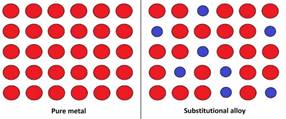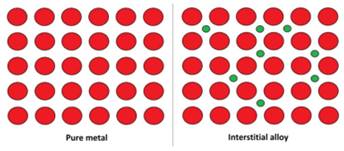
Interpretation:
The terms substitutional, interstitial, replaced and filled needs to be paired with the alloy types.
Concept introduction:
Alloy is mixture of two or more elements with metals which can be copper, zinc, tin, gold, silver, etc. This is being done to improve the properties of metals namely making them stronger or resistant to corrosion.
Answer to Problem 43SSC
The pairing of terms for alloys are (substitutional, replaced) and (interstitial, filled in).
Explanation of Solution
The formation of alloys involves two mechanisms, exchange of atom and interstitial mechanism. This is influenced by the size of the elements that are involved in the process.
- If the size of the atoms is same, then the preferred mechanism is exchange of where some atoms occupying the crystal lattice is exchanged with that of the other element. The bonding between these atoms is covalent as there is sharing of electrons. This is termed as substitutional alloy
- If the size of the atoms is smaller than the metal atoms, these added atoms will be filling holes in the metal lattice. Such alloys are interstitial alloys.


Hence, the pairing of terms for alloys are (substitutional, replaced) and (interstitial, filled in).
The pairing of terms for alloys are (substitutional, replaced) and ( interstitial, filled in).
Chapter 7 Solutions
Chemistry: Matter and Change
Additional Science Textbook Solutions
Essential Organic Chemistry (3rd Edition)
Chemistry: Structure and Properties (2nd Edition)
CHEMISTRY-TEXT
Organic Chemistry (8th Edition)
Organic Chemistry
Chemistry: The Central Science (14th Edition)
 ChemistryChemistryISBN:9781305957404Author:Steven S. Zumdahl, Susan A. Zumdahl, Donald J. DeCostePublisher:Cengage Learning
ChemistryChemistryISBN:9781305957404Author:Steven S. Zumdahl, Susan A. Zumdahl, Donald J. DeCostePublisher:Cengage Learning ChemistryChemistryISBN:9781259911156Author:Raymond Chang Dr., Jason Overby ProfessorPublisher:McGraw-Hill Education
ChemistryChemistryISBN:9781259911156Author:Raymond Chang Dr., Jason Overby ProfessorPublisher:McGraw-Hill Education Principles of Instrumental AnalysisChemistryISBN:9781305577213Author:Douglas A. Skoog, F. James Holler, Stanley R. CrouchPublisher:Cengage Learning
Principles of Instrumental AnalysisChemistryISBN:9781305577213Author:Douglas A. Skoog, F. James Holler, Stanley R. CrouchPublisher:Cengage Learning Organic ChemistryChemistryISBN:9780078021558Author:Janice Gorzynski Smith Dr.Publisher:McGraw-Hill Education
Organic ChemistryChemistryISBN:9780078021558Author:Janice Gorzynski Smith Dr.Publisher:McGraw-Hill Education Chemistry: Principles and ReactionsChemistryISBN:9781305079373Author:William L. Masterton, Cecile N. HurleyPublisher:Cengage Learning
Chemistry: Principles and ReactionsChemistryISBN:9781305079373Author:William L. Masterton, Cecile N. HurleyPublisher:Cengage Learning Elementary Principles of Chemical Processes, Bind...ChemistryISBN:9781118431221Author:Richard M. Felder, Ronald W. Rousseau, Lisa G. BullardPublisher:WILEY
Elementary Principles of Chemical Processes, Bind...ChemistryISBN:9781118431221Author:Richard M. Felder, Ronald W. Rousseau, Lisa G. BullardPublisher:WILEY





